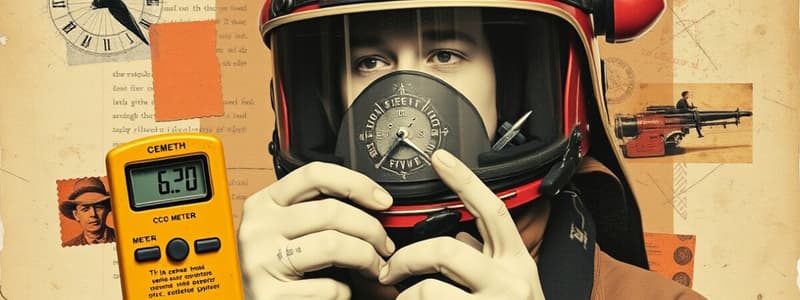Podcast
Questions and Answers
What is the primary purpose of a CO meter issued to suppression and rescue units?
What is the primary purpose of a CO meter issued to suppression and rescue units?
Where should the CO meter assigned to battalion chief units be stored?
Where should the CO meter assigned to battalion chief units be stored?
What should the Officer-in-Charge do if the CO meter detects CO in the apparatus?
What should the Officer-in-Charge do if the CO meter detects CO in the apparatus?
What is the maximum allowable parts per million (ppm) for CO readings before advising occupants not to inhabit the property?
What is the maximum allowable parts per million (ppm) for CO readings before advising occupants not to inhabit the property?
Signup and view all the answers
When a unit OIC decides to discontinue patient transport due to meter activation, what immediate action must be taken?
When a unit OIC decides to discontinue patient transport due to meter activation, what immediate action must be taken?
Signup and view all the answers
Which of the following is NOT a proper situation for using the CO meter?
Which of the following is NOT a proper situation for using the CO meter?
Signup and view all the answers
What procedure should be followed if CO is detected while on a non-fire call?
What procedure should be followed if CO is detected while on a non-fire call?
Signup and view all the answers
What is the operational life span of a CO meter?
What is the operational life span of a CO meter?
Signup and view all the answers
What common symptom is associated with mild acute CO poisoning?
What common symptom is associated with mild acute CO poisoning?
Signup and view all the answers
What should be done immediately after a high alarm activation on the CO meter?
What should be done immediately after a high alarm activation on the CO meter?
Signup and view all the answers
Which statement regarding the CO meter's low alarm is true?
Which statement regarding the CO meter's low alarm is true?
Signup and view all the answers
Which of the following is a characteristic of carbon monoxide (CO)?
Which of the following is a characteristic of carbon monoxide (CO)?
Signup and view all the answers
What testing procedure is required to ensure the CO meter's accuracy?
What testing procedure is required to ensure the CO meter's accuracy?
Signup and view all the answers
What should be done if there is a question regarding the CO meter’s operation or accuracy?
What should be done if there is a question regarding the CO meter’s operation or accuracy?
Signup and view all the answers
What must the unit OIC ensure before allowing crews to re-enter a structure affected by CO?
What must the unit OIC ensure before allowing crews to re-enter a structure affected by CO?
Signup and view all the answers
What is the primary reason for not attempting to ventilate the structure until confirmed by a HazMat unit?
What is the primary reason for not attempting to ventilate the structure until confirmed by a HazMat unit?
Signup and view all the answers
What document must be completed if a CO meter is lost or damaged?
What document must be completed if a CO meter is lost or damaged?
Signup and view all the answers
What should be done if CO readings confirm the presence of CO after a meter activation during transport?
What should be done if CO readings confirm the presence of CO after a meter activation during transport?
Signup and view all the answers
Study Notes
CO Meter Issuance and Responsibility
- Every suppression, rescue, and battalion unit will receive a Carbon Monoxide (CO) meter.
- Unit Officers-in-Charge (OIC) are responsible for the meter's presence and calibration.
- The CO meter has a fixed operational life of five years and is issued activated, requiring no battery replacement.
Situations for CO Meter Usage
- Meter is used in the apparatus, during non-fire emergencies (e.g., EMS responses, public assists), and post-fire to assess CO levels.
- The CO meter should not be employed during active fire suppression or investigation operations.
Meter Storage Guidelines
- Suppression and rescue unit meters are kept attached to the EPCR tablet's strap.
- Battalion chief unit meters are stored in the passenger cab, secured to the Mobile Computer Unit handle.
Calibration and CO Properties
- Calibration involves testing sensor accuracy by exposing the meter to a test gas.
- Carbon Monoxide (CO) is colorless, odorless, tasteless, and highly toxic, produced from incomplete combustion of fuels.
- CO binds with hemoglobin in blood, hindering oxygen transport and potentially causing tissue hypoxia.
Signs and Symptoms of CO Poisoning
- Common symptoms include headache, nausea, vomiting, dizziness, fatigue, and weakness.
General Guidelines for CO Detection
- If CO is detected:
- In apparatus: Shut down the unit, evacuate personnel, notify relevant officials, and call a HazMat unit.
- During non-fire calls: Evacuate occupants from affected areas, notify the Fire Alarm Office, and secure the scene.
- Post-fire: Use the meter to determine CO presence; readings must be documented, and occupancy warnings issued.
Maintenance of the CO Meter
- After high alarm activation, the meter should be placed in an open environment until readings return to zero, avoiding exposure to exhaust.
- Keep meter cover clean with a damp cloth; do not use solvents or cleaners.
- Avoid storing the meter near silicone lubricants or chemicals to prevent sensor saturation.
Alarm Notification Procedures
- Alarms activate when gas concentrations exceed pre-set limits, remaining on until acceptable levels are achieved.
- Low Alarm: One beep, flash, and vibration per second at 25 parts per million (ppm).
- High Alarm: Two beeps, flashes, and vibrations per second at 100 ppm.
Replacement Procedures
- For meter replacement, complete an online HazMat Service Request.
- If the meter is lost, damaged, or stolen, submit a Lost or Damaged Property Form and obtain a police report and investigative memorandum from the Battalion Chief.
Studying That Suits You
Use AI to generate personalized quizzes and flashcards to suit your learning preferences.
Description
This quiz covers the procedures and responsibilities regarding the issuance and management of CO meters in suppression, rescue, and battalion units. It highlights calibration requirements, operational life, and the intended use of the CO meter in various situations. Understanding these aspects is crucial for effective operational safety.




